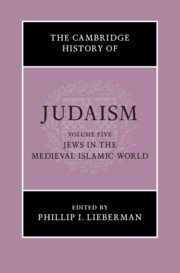Book contents
- The Cambridge History of Judaism
- The Cambridge History of Judaism
- The Cambridge History of Judaism
- Copyright page
- Contents
- Figures
- Acknowledgments
- Introduction
- Part I Jews in the Medieval Islamic World
- A. The Islamic World in the Middle Ages
- B. Regional Surveys
- Chapter 4 The Maghrib and Egypt
- Chapter 5 The Jews of Muslim Spain
- Chapter 6 Beyond Crescent and Cross
- Chapter 7 Yemen and India from the rise of Islam to 1500
- Chapter 8 The Jews of Northern Arabia in Early Islam
- Chapter 9 Judaism in Pre-Islamic Arabia
- Chapter 10 The Islamic East
- Part II Social and Institutional History
- Part III Spiritual and Intellectual History
- Index
- References
Chapter 7 - Yemen and India from the rise of Islam to 1500
from B. - Regional Surveys
Published online by Cambridge University Press: 21 August 2021
- The Cambridge History of Judaism
- The Cambridge History of Judaism
- The Cambridge History of Judaism
- Copyright page
- Contents
- Figures
- Acknowledgments
- Introduction
- Part I Jews in the Medieval Islamic World
- A. The Islamic World in the Middle Ages
- B. Regional Surveys
- Chapter 4 The Maghrib and Egypt
- Chapter 5 The Jews of Muslim Spain
- Chapter 6 Beyond Crescent and Cross
- Chapter 7 Yemen and India from the rise of Islam to 1500
- Chapter 8 The Jews of Northern Arabia in Early Islam
- Chapter 9 Judaism in Pre-Islamic Arabia
- Chapter 10 The Islamic East
- Part II Social and Institutional History
- Part III Spiritual and Intellectual History
- Index
- References
Summary
The Jewish community of the Yemen is well known for having been amongst the oldest in the Arabian Peninsula with origins in the early first millennium ce, if not far earlier since oral traditions recall a first arrival even before the destruction of the First Temple in 587 bce. As one of the most important contemporary scholars of Yemenite Judaism, Yosef (Joseph) Tobi, and other scholars, have noted, this timeline has strongly impacted scholarship on Yemenite Jewry, leading some of the early scholarship on Yemenite Jews to express a “romantic, even Orientalist, view that perceives this community as … embodying unchanged ancient tenets of Judaism from the Talmudic period, and resembling an ‘authentic’ old Jewish society.” This chapter joins a body of more critical approaches now emerging that understand Yemenite Jewry as a dynamic and complex society and it is for this reason that readers find the Yemen paired here with India, a region where firm evidence for a Jewish presence before 1500, and in particular the matter of first arrivals, continues to elude scholars and generates as much debate as the Yemenite material. If this chapter skirts the question of “first arrivals,” it nevertheless links the two regions because a large proportion of it will focus on the exceptional documentary corpus known as the Cairo Genizah and more specifically the body of documents that S. D. Goitein nicknamed his “India Book,” material relating to the Jewish trade between the eastern Mediterranean and South Asia, via the Yemen. While the Yemen, and ʿAden in particular, remain at the center of “India Book” documents, all of this material is deeply entangled through trade, travel, and marriage with South Asia and wider Mediterranean and Indian Ocean networks. The wider context for these connections is, of course, the trans-Eurasian trade boom of the period. The “India Book” material within the Cairo Genizah offers exceptional opportunities to flesh out for the Yemen, but also India, what otherwise remains the barest bones of Jewish history. This material, together with local literary production and extra-communal sources dating to the twelfth to fourteenth centuries – much of it in fact recovered from the Cairo Genizah – offers the potential for new histories and discourses. We start, though, with these barest of bones and the broad outlines of the history of Jews in the Yemen and India.
- Type
- Chapter
- Information
- The Cambridge History of Judaism , pp. 223 - 254Publisher: Cambridge University PressPrint publication year: 2021



